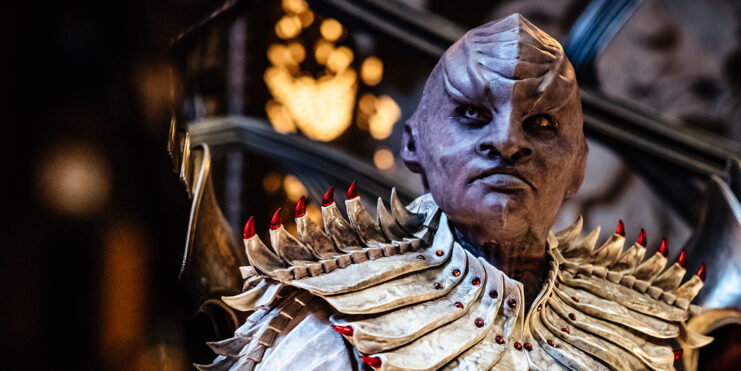When Star Trek: Discovery changed the look of the Klingons it caused ruptures in the space-time continuum but it’s not the first, and won’t be the last, time that Trek has tweaked its alien gallery. Rich Handley maps their foreheads from 52 years of Star Trek. It’s a bumpy ride!
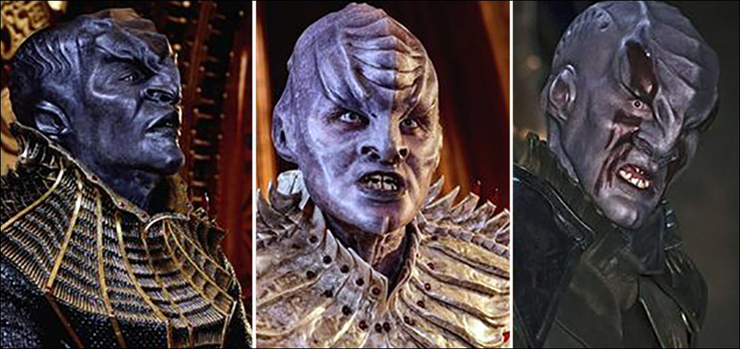
Ever since the first images of Star Trek: Discovery’s re-imagining of the Klingons were posted online, fans have vigorously debated the merits of the new design. Gone were the forehead bumps, beards, long locks and otherwise human faces that, for decades, had denoted the standard for a proud Klingon warrior; in their place were macrocephalic and hairless craniums with flaring, four-nostriled noses, flat ears, glossy skin and a Bolian-like chin line. “What the hell?” cried half of the fandom in unison.
But, then, Star Trek fandom has always been a powder keg waiting to ignite when it comes to anything that deviates from established canon. The most recent example was the casting of Benedict Cumberbatch, a thinly built, pale-skinned Caucasian, as Khan Noonien Singh, a Sikh Indian previously portrayed by muscular Mexican actor Ricardo Montalbán. IDW retconned this change quite satisfactorily in the pages of its comic book miniseries Star Trek: Khan, but many saw such whitewashing as problematic.
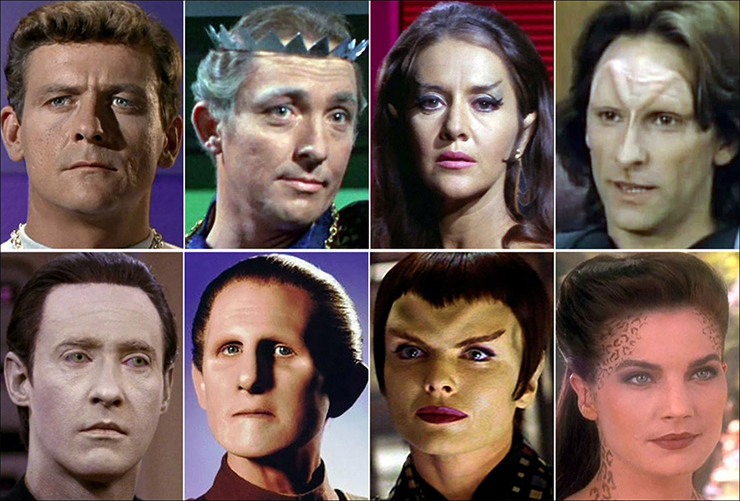
That was hardly the first time the franchise had tweaked or ignored continuity, however. The Next Generation’s Lieutenant Data was the only known sentient android… other than an entire planet full of them in “I, Mudd.” Deep Space Nine’s shapeshifter Odo was a one-of-a-kind anomaly… if one didn’t count the entire populations of the planets Antos IV, Excalbia, Kelva, Vendor, Dakala, Tau Alpha C, Devidia II, Sothis III, and Daled IV, as well as the homeworlds of the Chameloids and Gary Seven’s companion Isis. Jadzia Dax’s sexy spots on DS9 defined the look of the Trill hosts thereafter… even though Trill Ambassador Odan had looked completely different on The Next Generation.
The Romulans looked just like Vulcans because the schism between those societies had not happened long enough ago to allow for evolutionary changes… until TNG gave them forehead creases. The holodeck aboard Jean-Luc Picard’s Enterprise was something new and wondrous… even though James Kirk’s Enterprise had contained one a century prior on The Animated Series, and even though Trip Tucker had experienced such technology a century before that on Star Trek: Enterprise.
All of these discrepancies, viewers learned to accept. Data, Odo and Dax all became fan favorites, while TNG did a fantastic job of fleshing out Romulan society. Yet some vocal fandom factions have derided Discovery’s changes to Klingon anatomy as though this is the first time Star Trek has violated its own canon. It isn’t—not by a long shot.
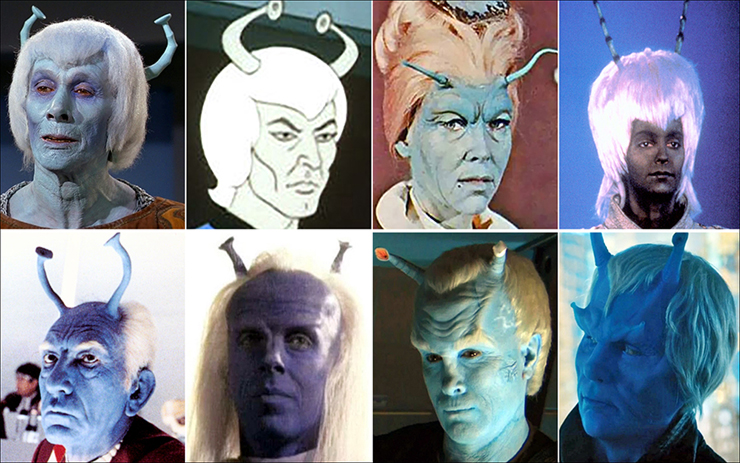
Consider the question of when Kirk’s five-year mission takes place. The 23rd century, you say? Ah, then why does “Space Seed” set it 200 years after the 1990s, and why does “The Squire of Gothos” set it 900 years after the 1800s? Is Kirk’s middle initial R. or T.? Does he have three nephews or one? Consider also the many different looks given to the Andorians and Tellarites since their debut in “Journey to Babel.”
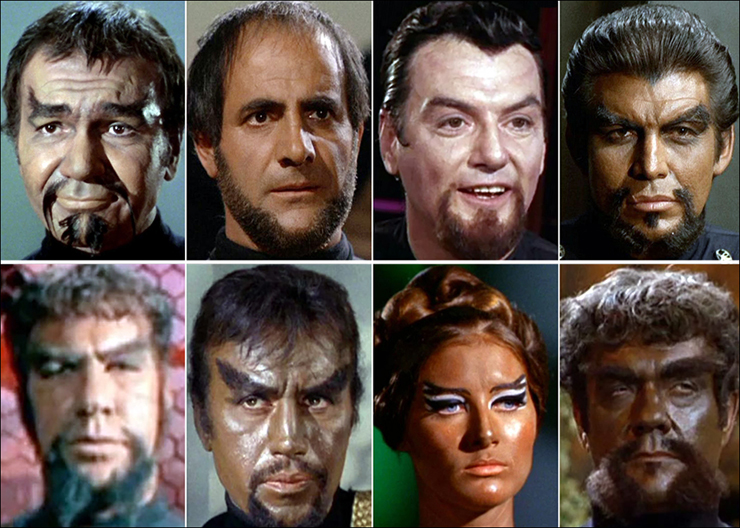
In short, Star Trek has always violated its own canon—entire books have been written on the subject. So why are the latest changes to the Klingons viewed as egregious? Note that I said the latest changes. Discovery’s take on the Klingons is far from the first time the species has been reinvented. Their appearance was, of course, radically changed in Star Trek: The Motion Picture, but that was not last time they would be altered—nor was it even the first.
The Klingons were introduced in “Errand of Mercy,” with Kor sporting bifurcated eyebrows and a Fu Manchu moustache and goatee, while his underlings had no facial hair at all and simply looked human. In “Friday’s Child,” Kras had normal human eyebrows and a chin-strap beard, whereas “The Trouble With Tribbles” went for a middle-ground approach, with Koloth having raised eyebrows but Korax’s looking more like Kras’s.
Krell, from “A Private Little War,” sported bushy eyebrows and a slicked-back hairdo that would make Grease’s Danny Zuko proud, while the eyebrows of the unnamed Klingon in “Elaan of Troyius” had decidedly Vulcan-like points. Then there’s “Day of the Dove,” in which Kang and Mara had noticeably shiny, coppery skin, while Mara also had double eyebrows (Kang’s were pointy and massive). The hirsute Kahless, meanwhile, seemed almost Neanderthal in appearance in “The Savage Curtain.”
Now, these difference could simply be chalked up to stylistic choices or racial variances. Head and facial-hair styles vary widely among Earth cultures, eras, financial classes and locales, and the same could be true of Klingons. Still, Klingon makeup definitely changed from one episode to the next in the 1960s, particularly with regard to Kras, Mara and Kahless, setting the stage for what would be a complicated aesthetic evolution.
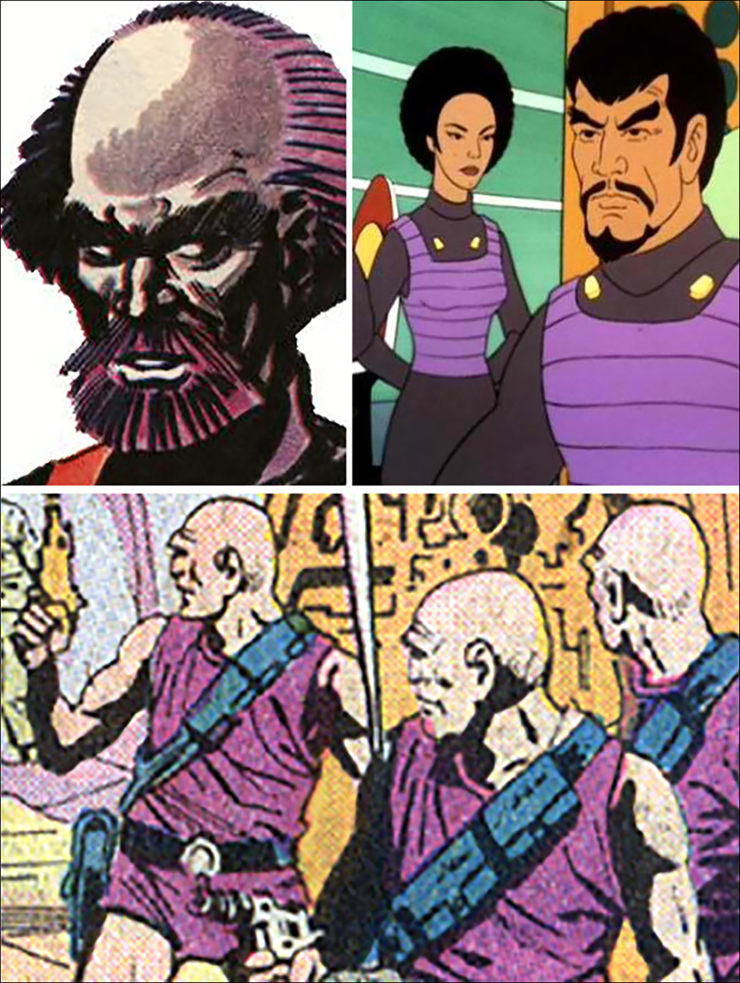
The Animated Series didn’t change the Klingons’ faces, though it did give them snazzy purple vests. The British comic strips made a significant alteration, though, by making them look remarkably like Lieutenant Worf, but without cranial ridges! Later British stories would ignore this design, with pretty much every Klingon resembling Koloth. Gold Key’s comics, meanwhile, sometimes drew them as bald, protruding-browed humanoids clad in purple, Robin Hood-esque leotards.
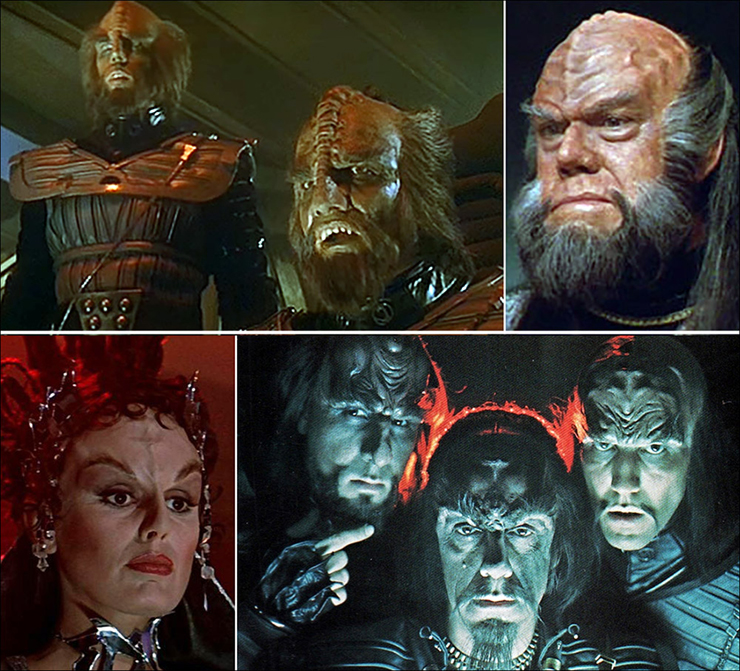
This brings us to The Motion Picture, when Mark Lenard’s unnamed commander and his crew showed up with what appeared to be identical lobsters glued to their heads, all the way down to their noses. This represented the first drastic departure when it came to Klingon anatomy, leaving audience members thinking “Wait… those are Klingons?!” Regardless, the new design stuck—sort of.
The Motion Picture was the only time the lobster-headed variety appeared, other than in licensed tie-in comics. When the Klingons returned in Star Trek III: The Search for Spock, the crustaceans had been replaced with turtle shells. What’s more, every Klingon now featured different ridges. Consider the head appliances used for Kruge, Maltz, Torg and Valkris—they’re so varied, they’re practically different species. But that was just the tip of the redesign iceberg. Picture Star Trek III’s Klingons next to Ambassador Kamarag, from The Voyage Home, and you’ll notice that the ridge differences are striking.
We humans vary widely, of course, in terms of height, weight, skin colour, eye colour and so forth, but we all (setting aside birth defects, amputations and diseases) have our facial features in the same configuration, our hands extending from the ends of our arms, our foreheads wrinkles running horizontally and so forth. Imagine seeing a person on the street with eyes stacked rather than next to each other, or with a nose above the eyes instead of below, or with hands attached to elbows, or with vertical forehead wrinkles. That is how radically different Maltz’s and Kruge’s foreheads are from each other and from Kamarag’s, yet we have no trouble seeing them all as being of the same
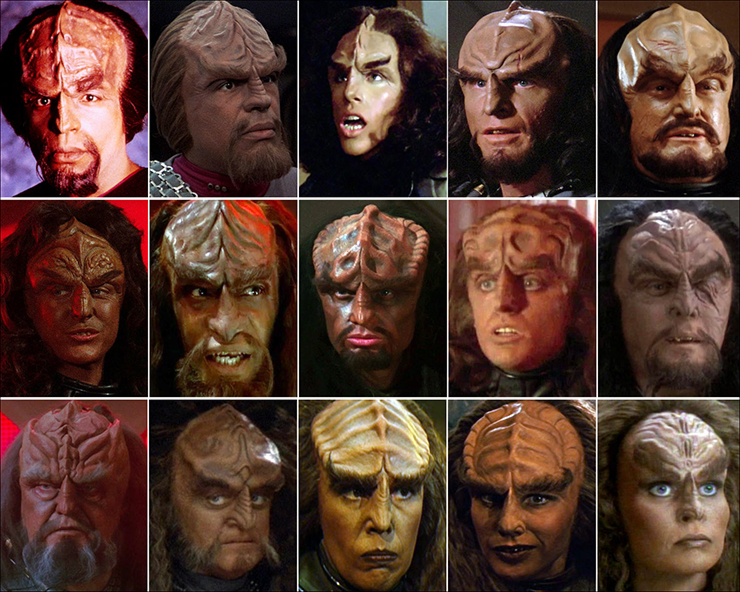
By the time The Next Generation and Deep Space Nine rolled around, all bets were off, with every Klingon displaying massive variances in cranial structure. Compare Worf’s look (or looks, since his forehead changed several times—canon violation alert!) with those of the female Klingon sexpot from “Hide and Q”; Korris and Konmel from “Heart of Glory”; Vekma from “A Matter of Honor”; Kurn and Duras from “Sins of the Father”; K’mpec, Gowron, Lursa and B’Etor from “Reunion”; Toral from “Redemption”; Grilka from “The House of Quark”; Martok from “The Way of the Warrior”; and so on. The variances are incredibly vast—and these are just a random handful of examples.
Enterprise made its own changes as well, with Klaang from “Broken Bow,” Korok from “Marauders,” Bu’kaH and the Somraw captain from “Sleeping Dogs,” Vorok from “Unexpected,” Antaak from “Divergence” and pretty much every other 22nd-century Klingon exhibiting head bumps as different from each other, and from the Klingons of prior shows, as our heads are from those of chimpanzees—but, again, we accept them as the same species.
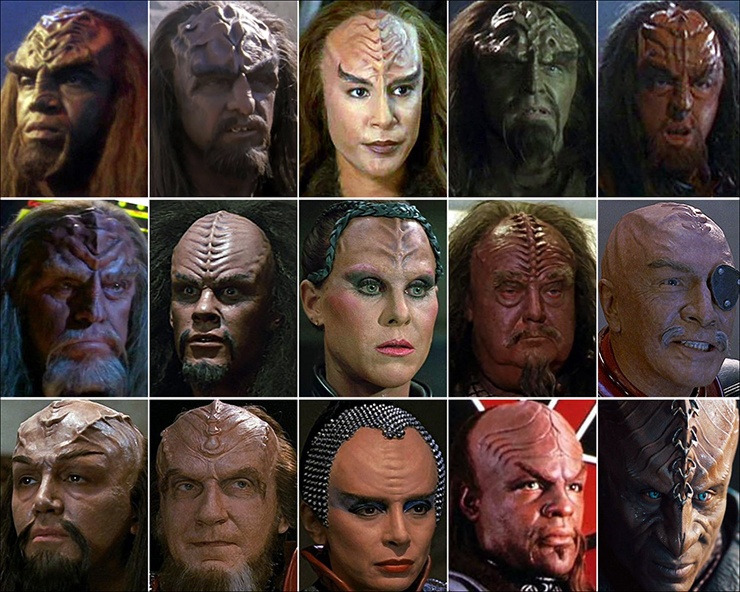
How about the films? In addition to characters from The Motion Picture, The Search for Spock and The Voyage Home, we have Klaa and Vixis from Star Trek V: The Final Frontier, who greatly differ from all other Klingons up to that point, as well as Korrd from that same movie, who comes surprisingly close to TMP’s lobster-heads. But it’s The Undiscovered Country that rips to shreds the notion of what Klingons look like. Examine Chang, Kerla, Gorkon, Azetbur and Colonel Worf. Now ask yourself how these characters could possibly be of the same species as TMP’s Klingons. Or Maltz. Or Vekma. Or Kras.
The deleted scenes from the 2009 Star Trek film, as well as Star Trek Into Darkness, feature a new breed of Klingons—one with ridges not only atop their hairless heads, but above each pointed and non-human-looking ear, along with a strangely shaped nose and cheek bulges. Their skulls almost come to a point in the middle, reminiscent of Louis Gossett Jr.’s Drac character from Enemy Mine. Granted, they’re in an alternate universe, but still—they’re Klingons.
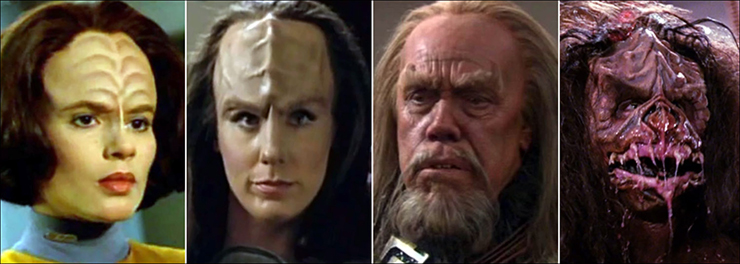
We can ignore Fek’lhr from “The Devil’s Due,” since he’s the Klingons’ mythical Devil (another violation of canon, by the way, since “Day of the Dove” tells us Klingons have no Devil), as well as Arne Darvin from “The Trouble With Tribbles,” since he has been surgically modified. Likewise, we can remove from the equation characters like K’Ehleyr, B’Elanna Torres, Ba’el, Miral Paris and Alexander Rozhenko, who are hybrids of two species and thus not fully Klingon, which would account for their facial variances.
What we mustn’t ignore is the Augment arc from Enterprise, which provides an official explanation for why some Klingons are smooth-headed while others have an endless variety of cranial ridges, bumps, whorls, raised spines, holes, jagged bulges and more. According to this arc, Klingons underwent an unexpected transformation in the 22nd century while attempting to modify themselves with Augment genetic material, when the resultant virus mutated and escaped quarantine, making those afflicted more human-like due to the dominance of Augment DNA.
This is key, as it explains a lot of the divergences. Given the virulence of the Augment virus, it may have spread throughout a large chunk of the population, causing many to appear human by Kirk’s time. The virus could then have re-mutated, become less virulent or been cured, resulting in ridges re-asserting themselves. That could explain the identical lobster heads in The Motion Picture—if they were the first batch cured, using a large infusion of Klingon DNA, they might have been an aberration or an over-compensation.
Greater diversity may have then emerged, accounting for all the vast differences—and it would explain why those in Star Trek V and VI have such low ridges, particularly Vixis, Azetbur, Chang and Colonel Worf: the Augment DNA stubbornly hung around, causing some to retain human characteristics (note that these Klingons are not unlike Torres’s half-human visage). That would even provide a context for Lieutenant Worf’s discomfort with discussing smooth-headed Klingons in “Trials and Tribble-actions”—he feels shame that his own lineage was among those afflicted.
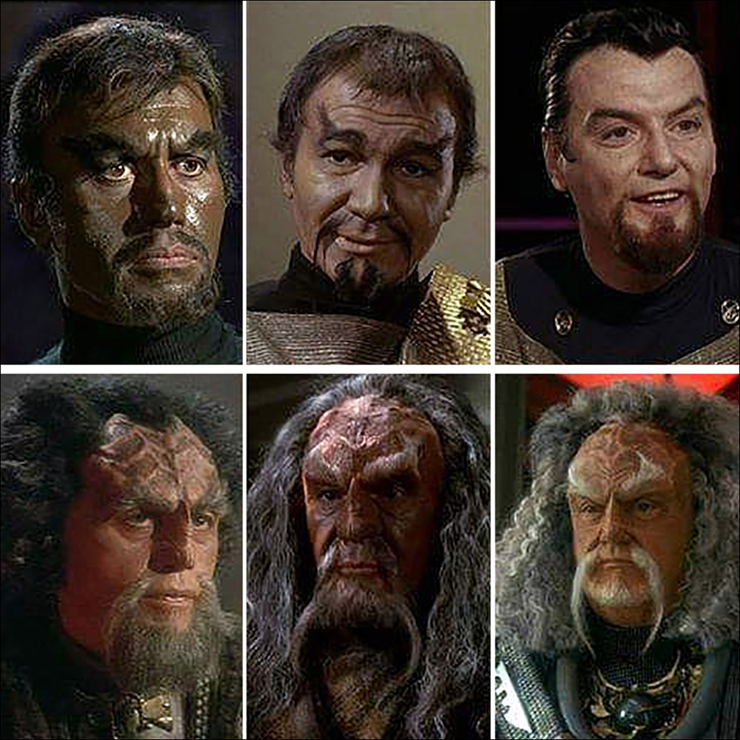
What it fails to explain is why no one in the 24th century knows about smooth-skinned Klingons, since video and photographic evidence would surely exist, but that could be chalked up to propaganda machines rewriting history. (Maybe Fox News still exists.) In any case, the surprise Worf’s crewmates exhibit upon seeing smooth-headed Klingons indicates that all Klingons have regained cranial ridges by the 24th century—which is borne out by the fact that not a single non-ridged Klingon appears on either TNG or DS9. This also explains why Kor, Kang and Koloth, upon returning as older Klingons on DS9, now sport cranial ridges: they have been cured of the affliction they suffered during their younger years. Voilà!
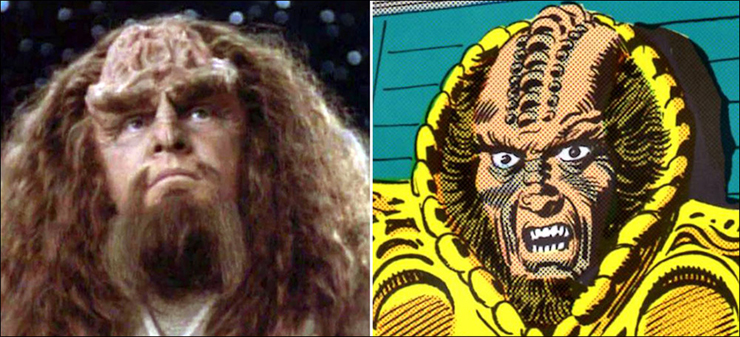
The biggest wrinkle here is Kahless. When we meet him in “The Savage Curtain,” he is several shades darker than any Klingon seen up to that point and, as noted above, has more primitive features. TNG’s “Rightful Heir,” however, not only gives him an extremely jagged forehead, but also noticeably lightens his skin color. This is difficult to reconcile, as Kahless lived many centuries prior to Enterprise and would thus not have been affected by the Augment virus.
The saving grace is that neither version of Kahless is actually Kahless the Unforgettable. The first is an illusion based on memories plucked from the minds of Kirk and Spock, while the second is a clone. Since memories are notoriously unreliable, and since the Starfleet officers grew up in an era in which Klingons look basically human (eyebrow and skin-colour differences aside), it makes sense that they’d imagine Kahless as being human-like. We can presume, then, that the clone version is likely how he actually looked.
Ultimately, what is a Klingon? Is he smooth-headed or ridged? Are his eyebrows human-like, pointy like a Vulcan’s, large and bushy, or bifurcated? Is his nose small and thin or wide and flat? Does it have two nostrils or four?
Do his ridges resemble a spinal column, or are they tall and thin, a single straight line or two curved lines? Are they on the top middle of his head only, a mosaic along the entire top of the skull, along the sides of the head above the ears, or in circular patterns? Does he have a full head of hair, a recessed hairline, facial hair, a clean-shaven face or a head entirely devoid of any hair? Is his torso human-like other than a spinal ridge, or is it lined with smaller ridges?
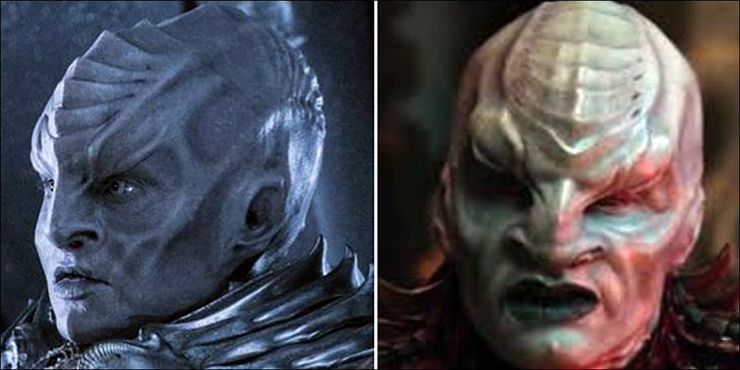
The answer is “All of the above,” which is why Discovery’s Klingons are not nearly as unusual or unprecedented as some would claim. They look different from what came before, yes. But so did The Motion Picture’s identical lobster heads. So did The Search for Spock’s diverse whorls and creases.
So did The Undiscovered Country’s flattened ridges. So did Worf’s fantasy lover in “Hide and Q,” with her fin-like head extension. So did Into Darkness’s alternate Klingons. And so did dozens of other Klingons along the way. There is so much biodiversity that it’s practically impossible to think of them as a single species.
Then again, why do need to? They’re an entire empire, not a single planet. They’ve conquered and subjugated worlds throughout their territory, and they may have interbred with the citizens of those planets or absorbed them fully into Klingon culture.
This has been going on for centuries, so by the eras of Kirk and Picard, there could be dozens of different Klingon species, not just one. When you add the effects of the Augment virus into the mix, the potential for radical variation becomes more compounded. Discovery’s Klingons might be the long-term result of the virus, for all we know, or they might simply be the species that control the Empire in the 2250s.
The show’s writers may opt to explain why the new Klingons look so different than the old—or they might not. Either way, it doesn’t really matter. These Klingons are merely the latest variation among many. Because we’ve never seen them before doesn’t mean they didn’t exist—just ask the Remans. When it comes to the Klingon Empire, variation has always existed, right from the beginning. As the franchise continues to expand, so does our understanding of this enigmatic, complex and extraordinarily biodiverse culture.

